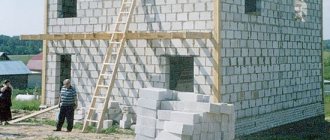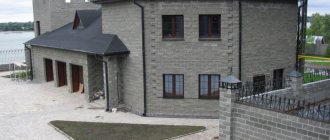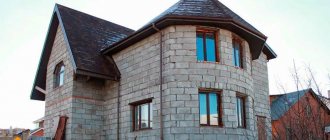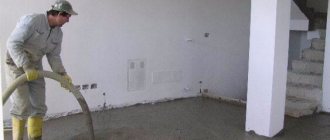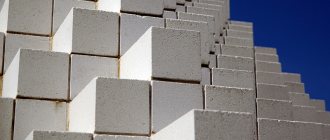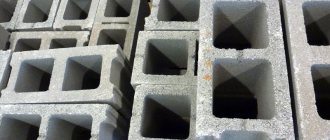Monolithic foam concrete is one of the modern materials that is actively used in construction today due to its many advantages. Foam concrete can be used to design buildings of various layouts, construct them efficiently and quickly, with minimal investment of time and money.
The main advantages of the material are lightness, ease of processing, resistance to atmospheric destructive factors, organic and environmentally friendly, non-susceptibility to bacterial and fungal infections. A house made of monolithic foam concrete is durable, without cold bridges, with smooth walls without the need for additional leveling.
A building can be constructed in 2-3 weeks, using mobile equipment and a minimum number of workers. Thanks to this, the cost of the house is relatively low, even in comparison with the construction of a building from ready-made blocks. Monolithic buildings are durable, safe, and environmentally friendly.
But before choosing such a project, it is worth considering all its advantages and disadvantages, features and nuances.
Easy solution
When describing houses made of monolithic foam concrete, contractors immediately focus on speed, cheapness and reliability. Moreover, you can build an inexpensive mansion with your own hands, investing a minimum of effort and time in the process.
What kind of material
Foam concrete is a lightweight porous building material based on a concrete mixture. Its pores are closed (unlike aerated concrete) - that is, in the thickness of the monolith the bubbles are isolated from one another. Therefore, the material is not afraid of moisture and demonstrates excellent frost resistance characteristics.
Foam concrete blocks are made from sand, cement, water, special foam concentrate and hardener. Thanks to the special structure of foam concrete, it demonstrates characteristics that are ideal for residential construction - environmental friendliness, the ability to create an optimal indoor microclimate, the creation of “breathable” walls, and heat conservation.
Properties of foam concrete in comparison with other materials:
- Like concrete - strength, solidity, resistance to external negative factors, durability, high level of fire resistance
- Like wood - good nailability, ease of processing, sawability
- Like mineral insulation - good sound insulation, ease of installation, light weight, low thermal conductivity
Mode of production
Foam concrete is produced by mixing prepared foam in a foam generator or pressure mixer with sand-cement mortar. During the production process, air bubbles appear, making the material lighter and less dense. The density parameter is adjusted depending on the purpose of the material. To create a block, 2-4 times less cement is consumed than to produce conventional blocks.
The quality of the material is directly proportional to the correct selection of volumes, the quality of the components, and compliance with all production technology.
Disadvantages of the material
Like any material, foam concrete has disadvantages. The porous structure, which provides sound absorption and thermal insulation, at the same time makes the material more fragile and brittle than conventional concrete.
Mixtures of low-density grades have low load-bearing capacity, therefore only high-density mixtures are used for multi-story construction.
Frost resistance indicators are also not very high (35 cycles). Also, monolithic foam concrete gains its strength only over time.
Simple construction
It is quite possible to create a house from monolithic foam concrete with your own hands, but here you need to carefully study the entire process and a number of features. All steps must be performed correctly and in a certain sequence.
First preparation
Before building a house on a finished foundation, by laying blocks or pouring material, preparation is carried out. First you need to build a supporting frame, then install the formwork, lay the electrical cable, and install ventilation ducts. Construction is carried out in the warm season - certainly not in winter, when the strength of the material may suffer.
Three ways
The construction of a house made of foam concrete can be carried out using several technologies, each of which has its own pros and cons and features.
Methods for building a house:
- Hard
– when load-bearing walls are made of brick, and foam concrete is used as a heat-insulating material. Space is left between the inner and outer masonry by providing a bandage. Then a metal mesh is laid in the rows for reinforcement, releasing it inside. The mass is poured into the created niches.
- Easy
– using a heat-conducting profile. Load-bearing metal structures are mounted under future pouring in order to support the formwork (can be removable or permanent). The roof is also cast from porous concrete.
- Combined
- when the outer wall is made of facing bricks, and the inner wall is made of panels, filled with foam concrete. Then the boards are either dismantled or left for later finishing.
The option of pouring foam concrete into permanent formwork is the simplest and fastest - the structure is assembled easily and quickly, then poured, guarantees the evenness of the walls and requires minimal finishing.
Tips for arranging formwork
During stripping, a problem may arise that the mortar adheres very tightly to the formwork and when dismantling it, the monolith may collapse. To prevent such a situation, it is necessary to take care, even before pouring the mixture, to reduce the adhesion of the formwork materials and foam concrete.
If we are talking about a wooden frame, the mixture sticks to it even more strongly than to iron or plastic. Therefore, the surface of the formwork must be treated with anti-adhesive lubricants. Hydrophobic lubricants or materials that slow down the setting of concrete can also serve. Thanks to this, the formwork structures can be used more than a dozen times.
Advantages and disadvantages
Building a house from monolithic foam concrete involves certain nuances. If everything were so simple and easy, then other materials would long ago be a thing of the past. But, taking into account the fact that today buildings are still being erected from brick, wood, and reinforced concrete slabs, it becomes obvious that foam concrete in some cases may not be relevant.
Obvious advantages
A monolithic house made of foam concrete is ideal for people to live in, as it is completely safe for health, has good air permeability, and does not allow the spread of dangerous microorganisms.
The main advantages of foam concrete:
- Low cost
- Minimum weight of blocks with a large size - an opportunity to save on installation
- Fast construction
- Ease of processing - foam concrete is easy to drill and saw, the blocks can be connected into a monolith of any configuration
- Environmental friendliness and safety for humans
- High level of sound insulation
- Excellent thermal insulation properties - walls made of monolithic foam concrete retain heat well, surpassing even wood and brick
- High level of heat/moisture resistance
- Possibility of implementing complex projects - any configuration, single or multi-story, with adjustable wall thickness as desired, creating volumetric premises
- Reducing reinforcement consumption by 20%
There are disadvantages
Among the disadvantages that a monolithic house made of foam concrete may have, it is worth noting: the inability to build in winter, the fragility of the material under point load, the fear of freezing and rapid destruction in the cold, the importance of strictly following the instructions and all rules when pouring (there is a risk of producing low-quality foam concrete from -unstable foam, incorrect selection of proportions of components, poor quality of the components themselves, etc.).
In addition, the foam concrete layer may crack during the shrinkage of the structure. The material is quite fragile and is susceptible to too high local loads, which must be taken into account.
As mentioned above, it is very important to follow the production technology of the material and the entire construction process, and there are not so many specialists on the market yet. This is due to the fact that the construction of houses from monolithic foam concrete is not yet very common at the moment.
It is impossible to build a multi-storey building from foam blocks - a maximum of 2-3 floors, which, however, is quite enough for residential construction.
Insulation
Since foam concrete is an excellent insulation material, it can also be used for already constructed walls. This is especially true for wooden and brick buildings. To do this, it is necessary to install formwork at a distance of 5-7 cm from the wall. It is this distance that is necessary for insulation with foam concrete.
The frame of such formwork can be constructed from metal profiles used in working with plasterboard. Using self-tapping screws, you can sew up such a frame with glass-magnesite sheets. They are also called magnesite slabs or glass magnesite. This frame cladding can serve as an excellent base for stone panels. Inside buildings, glass magnesite is also used as ceiling cladding or floor preparation.
As you can see, foam concrete has a wide range of applications, and supplying it in the form of a solution and creating a monolith as a result significantly increases its capabilities, which cannot be done using foam blocks.
What's special
Creating buildings from foam concrete takes on average 2-6 weeks. Monolithic foam concrete in permanent formwork guarantees the strength and durability of the building, and thanks to special formwork structures, finishing can be practically omitted. It will be enough to putty and paint the walls inside.
Communications are also easy to lay; window/door openings are created using reinforced concrete lintels. The floors are made of reinforced concrete sheets and wood.
In general, construction from foam concrete allows you to erect a building quickly, simply and cheaply. But the operational characteristics and relevance of such savings depend on the required parameters of the house, the correct execution of all stages of construction, the quality of the material, etc.
Solidification of the liquid mixture
Like any concrete solution, foam concrete releases moisture as it hardens. If evaporation occurs quickly (most often this can be observed in the summer and in hot weather), you need to control the moisture content of the material. This can be done by covering the poured surfaces with polyethylene and moistening them in the first days after pouring. This will help the solution set evenly.
However, it should be remembered that under no circumstances should you water the flooded surface with a stream of water. Also, if the air temperature drops below +5ºС, watering should be stopped.
As you can see, foam concrete as a material deserves attention due to its excellent characteristics, as well as its wide possibilities for use in construction.
Production
The material is manufactured in accordance with STO-001-50845180-2008 and TU 5745-002-50845180-2006. Work is carried out at ambient temperatures exceeding plus 10 degrees Celsius.
Since production takes place in “field” conditions, it is practical to use mobile installations for the production of foam concrete. These can be either compact pressure units or classic systems that include a foam generator.
The production technology of monolithic foam concrete is presented in the video below:
Prices for foam concrete with a volume of 30 m³ or more
| Type of work and density of foam concrete | Price m 3 * | Price m 2 * (H 10 cm) | |
| Wall insulation D300 (density 300 kg/m³) | 3200 rub. | 320 rub. | Order |
| Floor insulation D450 (density 450 kg/m³) | 3000 rub | 300 rub | Order |
| Roof insulation D200 (density 200 kg/m³) | 2800 rub. | 280 rub. | Order |
* The price for foam concrete is indicated for Moscow from 30 cubic meters * Prices may change, check the price for your city with managers!
ORDER NOW! And get FREE: - Delivery! - Filling! - Climb to heights!
Manufacturing technology
If you understand the principle of obtaining a new building material, it is easier to understand what it is. Cement, sand, water and foaming agent are used for production. After combining the components, the finished foam is introduced into the concrete mixer, which provides porosity. Organic and inorganic compounds are used to make foam. The main component for its creation is a surfactant, which reduces water tension and promotes the foaming process.
Finishing walls made of foam concrete
If we talk about exterior finishing, then walls made of foam concrete can be successfully lined with different materials or plastered. You can use lining, tiles, siding, natural or artificial stone finishing.
Also a good option is plastering the facade of the building with decorative plaster. There is a wide variety of finishing materials on the building materials market. This is the well-known bark beetle and decorative plaster, which is called “crumb” or “lamb” on an acrylic, silicate or silicone base.
As for interior work, the foam concrete wall can be plastered and puttied if necessary. You can also hang wallpaper or carry out other interior finishing work.
Pouring the floor
In this case, a certain effect is achieved:
- the mixture creates a uniform layer of the desired level on the surface of the coating. All uneven places and differences are hidden under it;
- transport costs for the supply of necessary materials are minimized;
- Foam concrete is easy to prepare at a construction site and is quickly supplied to the installation site;
- All work is carried out at high speed.
The technological process of arranging the screed does not require large labor costs, special equipment is not used, and there is also no need for additional transportation costs. Taking into account a lot of positive reviews, we can confidently recommend this technology for the floor.
All of the above qualities, taken together, make foam concrete indispensable when arranging floor screeds.
A combined method of arranging the floor is more effective, if a foam concrete solution with a density of 300 - 500 is poured down, and the top is made of a material whose density is slightly higher - 700 - 800 kg per cubic meter. In this case, there is no need to equip a concrete screed.
Floor structures made of foam concrete material are calculated and designed for each object, taking into account its purpose. When reconstructing objects, you can fill the floors with foam concrete with a density of 800 kg per cubic meter. m., which will make it possible to insulate the floor and level it.
Using a monolithic foam concrete mass when pouring a thick floor, an excellent effect is obtained, reducing the load on load-bearing walls by three times.
[my_custom_ad_shortcode4]

